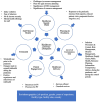Assessing the Disruption Impact on Healthcare Delivery
- PMID: 38907592
- PMCID: PMC11193933
- DOI: 10.1177/21501319241260351
Assessing the Disruption Impact on Healthcare Delivery
Abstract
Health emergency outbreaks such as the COVID-19 pandemic make it challenging for healthcare systems to ration medical resources and patient care. Such disastrous events have been increasing over the past years and are becoming inevitable, necessitating the need for healthcare to be well-prepared and resilient to unpredictable rises in demand. Quantitative and qualitative based decision support systems increase the effectiveness of planning, alleviating uncertainties associated with the crisis. This study aims to understand how the COVID-19 pandemic has affected the performance of healthcare systems in different areas and to address the associated disruption. A cross-sectional online survey was conducted in the Kingdom of Saudi Arabia and the United Arab Emirates among healthcare workers who worked during the pandemic. The pandemic-related disruption and its psychometric properties were assessed using Structural Equations Modeling (SEM) with 5 latent factors: Staff Mental Health, Communication Level, Planning and Readiness, Healthcare Supply Chain, and Telehealth. Responses from highly qualified participants with many years of experience in hospital settings were collected and analyzed. Results show that the model satisfactorily fits the data with a CLI of 0.91 and TLI of 0.88. The model indicates that enhancing supply chain management, planning, telehealth usage, and communication level across the healthcare system can mitigate the disruption. However, the lack of mental health management for healthcare workers can significantly disrupt the quality of delivered care. Staff mental health and healthcare supply chain, respectively, are the highest contributors to varying degrees of disruption in healthcare delivery. This study provides a direction for more research focusing on determinants of healthcare efficiency. It also provides decision-makers insights into the main factors leading to disruptions in healthcare systems, allowing them to shape their outbreak response and better prepare for future health emergencies.
Keywords: COVID-19; healthcare delivery disruption; healthcare supply chain; healthcare workers wellbeing; telehealth.
Conflict of interest statement
Declaration of Conflicting InterestsThe author(s) declared no potential conflicts of interest with respect to the research, authorship, and/or publication of this article.
Figures






Similar articles
-
Exploring Risk Perception, Mental Health, Mental Fatigue, Stigma, and the Quality of Life among UAE Healthcare Workers during the COVID-19 Pandemic: A National Multicentric Cross-Sectional Study.Int J Environ Res Public Health. 2024 Aug 26;21(9):1124. doi: 10.3390/ijerph21091124. Int J Environ Res Public Health. 2024. PMID: 39338007 Free PMC article.
-
The Resilience Hub approach for addressing mental health of health and social care workers during the COVID-19 pandemic: a mixed-methods evaluation.Health Soc Care Deliv Res. 2024 Sep;12(29):1-164. doi: 10.3310/HGQR5133. Health Soc Care Deliv Res. 2024. PMID: 39264827
-
Makkah healthcare cluster response, challenges, and interventions during COVID-19 pandemic: A qualitative study.J Infect Public Health. 2024 Jun;17(6):975-985. doi: 10.1016/j.jiph.2024.04.007. Epub 2024 Apr 16. J Infect Public Health. 2024. PMID: 38631067
-
Disruption to diabetes and hypertension care during the COVID-19 pandemic in Latin America and the Caribbean and mitigation approaches: a scoping review.BMC Health Serv Res. 2025 May 8;25(1):660. doi: 10.1186/s12913-025-12760-3. BMC Health Serv Res. 2025. PMID: 40341010 Free PMC article.
-
Intersecting factors of disadvantage and discrimination and their effect on daily life during the coronavirus pandemic: the CICADA-ME mixed-methods study.Health Soc Care Deliv Res. 2025 Feb;13(2):1-185. doi: 10.3310/KYTF4381. Health Soc Care Deliv Res. 2025. PMID: 39949202
Cited by
-
Sustainable development goals (SDGs) and resilient healthcare systems: Addressing medicine and public health challenges in conflict zones.Medicine (Baltimore). 2025 Feb 14;104(7):e41535. doi: 10.1097/MD.0000000000041535. Medicine (Baltimore). 2025. PMID: 39960902 Free PMC article. Review.
-
Large-scale screening of SARS-CoV-2 variants in Tokyo, Japan: A 3-year and 9-month longitudinal survey.Glob Health Med. 2025 Apr 30;7(2):151-160. doi: 10.35772/ghm.2025.01004. Glob Health Med. 2025. PMID: 40321450 Free PMC article.
References
-
- World Health Organization. COVID-19 Public Health Emergency of International Concern: Global Research and Innovation Forum, Towards a Research Roadmap. 2020. Accessed February 11, 2020. https://www.who.int/publications/m/item/covid-19-public-health-emergency...
-
- Johns Hopkins. John Hopkins Coronavirus Resource Center. Accessed December 3, 2021. https://coronavirus.jhu.edu/map.html
-
- Centers for Disease Control and Prevention. How to Protect Yourself and Others. Updated November 29, 2021. Accessed December 3, 2021. https://www.cdc.gov/coronavirus/2019-ncov/prevent-getting-sick/preventio...
Publication types
MeSH terms
LinkOut - more resources
Full Text Sources
Medical
Research Materials
Miscellaneous

